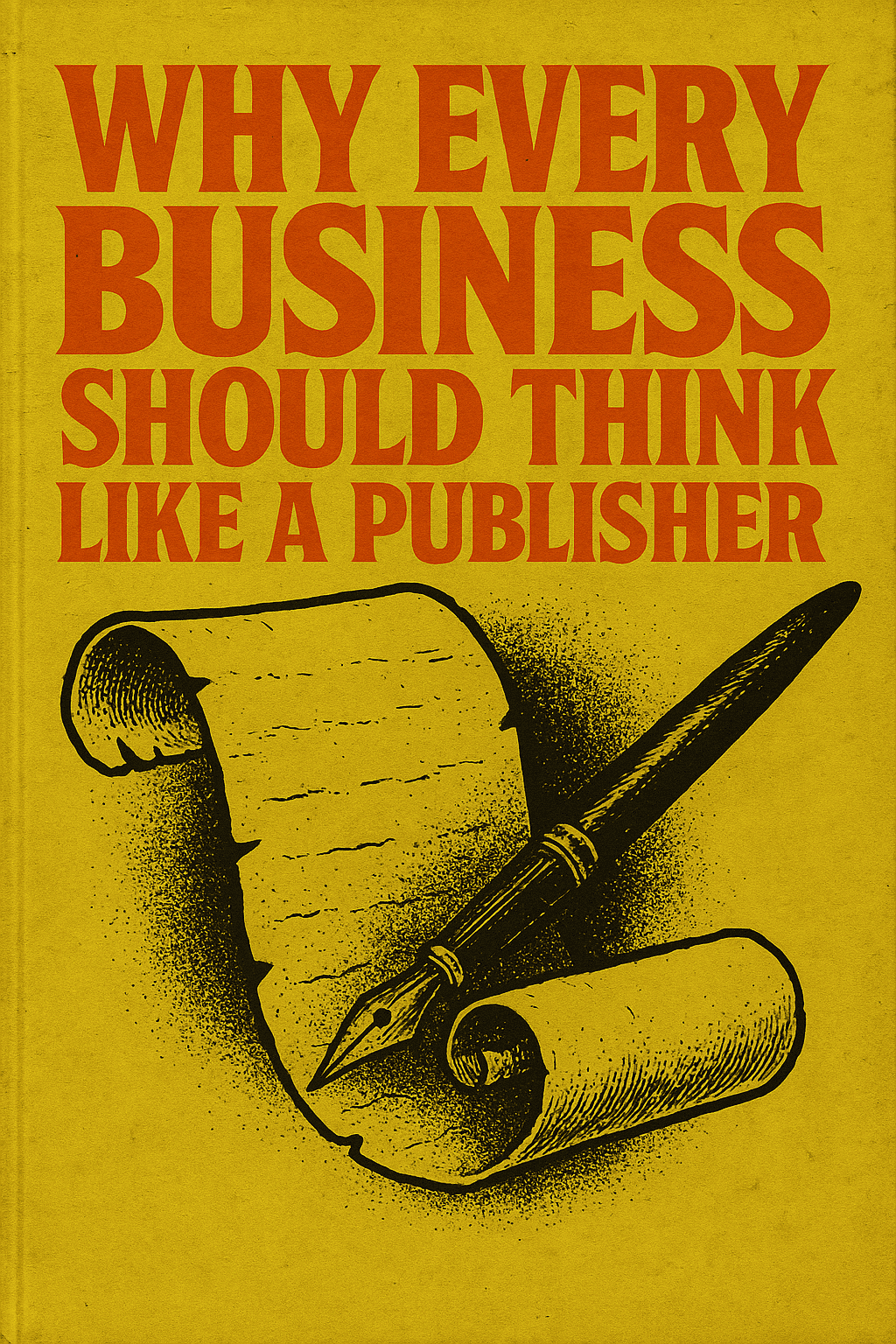
Businesses that thrive online aren’t the ones shouting the loudest. They’re the ones publishing the smartest. Companies that treat their websites and marketing channels like editorial platforms—consistent, strategic, and audience-driven—are building authority that no ad campaign can buy. They’re the voices people trust, the resources people return to, and the brands that keep showing up long after trends fade.
Whether you run a construction company in Longview or a national service brand, the mindset that separates the leaders from the rest isn’t “How do we sell more?” but “What do our customers need to learn next?”
From Selling to Storytelling
Traditional marketing still has its place—but it’s not the center of gravity anymore. The internet has shifted the balance of power from advertisers to audiences. Consumers scroll past generic promotions faster than ever, but they’ll stop for content that teaches, helps, or entertains. Storytelling creates that pause.
When you think like a publisher, you shift from pushing products to publishing perspective. Instead of blasting out promotions, you publish insights, walkthroughs, behind-the-scenes stories, and advice that position you as a trusted expert. People may not buy immediately—but they start to believe in your credibility. And that belief compounds over time.
Why This Matters
AI-generated content has flooded the web, and while it’s efficient, it’s also diluted. Search engines and readers alike are seeking signs of authenticity—real experience, human tone, and local relevance. Google’s updates have doubled down on “experience” as part of E-E-A-T (Experience, Expertise, Authoritativeness, and Trustworthiness). That means businesses with authentic voices win, and those chasing volume with generic content lose visibility fast.
Thinking like a publisher ensures that every piece of content you create reinforces your authority. It reminds both algorithms and humans that you’re not guessing—you’re guiding.
What Thinking Like a Publisher Really Means
Acting like a publisher doesn’t mean you need a newsroom or a film crew. It means adopting the systems and mindset of one. Publishers plan, schedule, and measure. They understand their audience and know that the value they give determines the value they receive. They don’t wait for inspiration—they build infrastructure that keeps the ideas flowing.
- Consistency beats intensity: It’s better to post regularly than to post perfectly.
- Focus on education, not exposure: Teach your audience something valuable and you’ll earn attention naturally.
- Think long-term: Every blog post, video, or newsletter is an investment in your reputation.
Building a Content Engine
The difference between occasional content and a publishing strategy is process. Successful publishers operate on systems that make creativity repeatable. You can do the same for your business without overcomplicating it.
- Start with pillars: Define 3–5 key topics your audience cares about most—these become the foundation for all your content.
- Create subtopics: Break each pillar into smaller ideas, FAQs, and how-tos.
- Plan a cadence: Set a schedule—once a week, twice a month—and stick to it religiously.
- Distribute smartly: Repurpose one post into multiple formats: short social posts, video clips, and newsletter segments.
This process turns chaos into rhythm. Over time, your site becomes a living library of expertise, and every new piece strengthens the last.
AI vs Authenticity: The Balancing Act
AI is a fantastic assistant—it can help brainstorm ideas, structure outlines, and automate distribution—but it can’t replace your experience. The most effective publishers combine the efficiency of AI with the nuance of human insight. You might use AI to surface trending questions in your niche, but your human expertise answers them better than any algorithm could.
The future belongs to businesses that use technology to amplify—not replace—their authenticity. Let AI handle the busywork while you focus on what only you can bring: voice, empathy, and originality.
Maintaining Your Voice as You Scale Publishing
One challenge of consistent publishing is keeping your tone and values intact, especially as your team or contributors grow. Your voice is your brand—it’s how customers feel your personality in every paragraph. To keep that voice consistent, establish editorial guidelines. They don’t have to be complicated, just clear:
- Use the same tone across blog, social, and email content (for Graticle, that’s conversational but confident).
- Define what you stand for and what you avoid (no jargon, no empty hype).
- Keep your customer’s perspective front and center—always write to solve, not to sell.
Publishing at scale doesn’t mean losing personality. It means codifying it so it stays recognizable no matter who’s writing.
Start With an Editorial Mindset
Publishers plan ahead. They know that consistency drives discovery. Treat your marketing calendar like an editorial roadmap. Align your posts with seasonal trends, industry moments, or customer pain points. For instance, a roofing company might focus on storm preparation tips in March, while a local café might post holiday catering ideas in November.
Editorial planning gives purpose to your publishing and prevents the all-too-common “we should post something” scramble. When every piece of content has intention behind it, your brand becomes magnetic.
Turning Data Into Editorial Insight
Data isn’t just numbers—it’s direction. Every analytic metric tells a story about what your audience values. Review performance monthly. Which posts get the most clicks? Which pages have the longest read times? Those aren’t just stats; they’re your editorial compass.
Over time, data shows you what resonates. Maybe tutorials outperform opinion pieces. Maybe long-form content converts better than short updates. Let data shape your content roadmap without stripping away creativity. Smart publishers listen to feedback in real time and adjust before competitors catch up.
How Publishing Boosts SEO (and Why It’s the Future of Visibility)
Search engines don’t reward noise—they reward authority. Every new post you publish is another opportunity to capture organic search traffic. But SEO isn’t just about keywords; it’s about demonstrating depth and trust. Google’s ranking systems now analyze topical authority—how consistently you cover related subjects and whether your insights demonstrate firsthand experience.
That’s why thinking like a publisher is the best SEO strategy there is. You’re not just optimizing a few pages; you’re building a body of work that reinforces your expertise again and again. The more cohesive your publishing, the stronger your search footprint becomes.
Content Formats That Work
Publishing is no longer just about text. Audiences absorb information in different ways, and smart businesses meet them where they are. The key is to diversify formats without spreading yourself thin:
- Written: Blog posts, whitepapers, and newsletters remain SEO gold.
- Video: Short-form tutorials and behind-the-scenes clips drive high engagement on social.
- Audio: Podcasts create a deeper connection for people who prefer listening.
- Interactive: Quizzes, calculators, or design configurators turn learning into participation.
The best publishers use each piece of content multiple ways. One long article can feed five short videos, a week’s worth of social content, and a monthly newsletter. It’s not about doing more—it’s about doing smarter.
Storytelling Builds Connection
Facts inform, but stories stick. Every business has stories worth telling—how you started, what challenges you’ve overcome, or how you’ve helped customers solve real problems. Storytelling isn’t fluff; it’s context. It shows why your expertise matters.
When people see themselves in your stories, they connect emotionally. And when they connect emotionally, they remember you when it’s time to buy. Thinking like a publisher means weaving those stories naturally into your regular content so they’re part of your ongoing narrative—not one-off campaigns.
Publishing as a Trust Signal
Customers use content as a filter for credibility. They might not tell you, but before reaching out, they’ve already read your blog, scanned your FAQs, or watched a video. Each piece of content becomes a silent salesperson, building confidence before you ever meet.
Today this is especially true with generative search tools summarizing answers directly in results. If your brand isn’t producing trustworthy, structured, and relevant content, you’re invisible in those summaries. Thinking like a publisher keeps you visible in the evolving search landscape—where authority is earned, not bought.
Common Mistakes to Avoid
- Publishing without direction: Random posts dilute your brand message.
- Chasing trends: Jumping on every new format loses focus and confuses your audience.
- Ignoring design: Poor layout kills engagement. Publishing is presentation too.
- Inconsistency: Stopping for months resets your momentum—and your trust.
- Neglecting distribution: If no one sees your content, it doesn’t exist. Share strategically.
Keeping It Manageable
Publishing doesn’t have to take over your schedule. Start small, stay consistent, and grow into it. One article a month. One email per quarter. The goal isn’t perfection—it’s presence. Small, steady output beats big bursts that burn out fast.
Over time, you’ll notice something powerful: publishing makes you sharper. It forces you to clarify your ideas, document your process, and keep learning. You’re not just building an audience—you’re building discipline.
Why Publishing Outperforms Paid Ads Over Time
Ads have a short shelf life. Once the spend stops, so does the visibility. Publishing, on the other hand, compounds. That one well-written post from last year might still bring in traffic today. It keeps working quietly in the background, building trust while you focus on your craft.
Every article, guide, and video becomes a digital asset that grows in value over time. That’s why businesses that publish regularly can eventually reduce their dependence on paid campaigns. They don’t have to rent attention—they own it.
Building a Culture of Publishing
To truly think like a publisher, make content everyone’s responsibility—not just marketing’s. Encourage your team to share insights, document processes, and celebrate results. When your company culture values publishing, content becomes part of your identity, not an afterthought.
Invite subject matter experts to contribute ideas. Capture stories from the field. Turn team wins into teachable moments for your audience. Every person in your company has knowledge that can be shaped into content. Publishers know how to capture and refine that knowledge so it lives online.
How Graticle Design Helps Businesses Publish Better
At Graticle Design, we’ve seen how powerful this shift can be. We help businesses turn their websites into living publishing platforms—fast, optimized, and easy to manage. From content strategy and SEO structure to web design that highlights your best work, we make sure your publishing engine runs smoothly. And because we handle hosting, maintenance, and performance, you can focus on creating instead of troubleshooting.
Your stories deserve to look as good as they sound—and we make sure they do.
Every Business Has a Story Worth Telling
The difference between the brands people scroll past and the ones they trust comes down to who’s publishing with purpose. Acting like a publisher transforms your website from a brochure into a resource. It replaces guesswork with strategy, replaces advertising with authority, and replaces transactions with trust.
The sooner you start, the more momentum you build. Don’t just market. Publish. Be the source your customers trust, the voice your industry respects, and the brand people remember.
Ready to publish with purpose? Contact Graticle Design today. Let’s build a website that tells your story, earns authority, and keeps your business growing for years to come.





